
The Red Cross Committee - July, 1939
When Sir Hubert and Lady Young arrived in Trinidad in 1938 whites comprised about 3% of the population. (Today it is less than 1%) Whatever white people may have felt privately about racial matters, they were locked into a system of exclusivity and preferment over people of colour that limited their ability to bring about any change. To hire a maid meant hiring a black maid. This also made it largely irrelevant to accuse another white person of racism. They were all in it together.
Apparently Governor Young didn't see it that way. During the battle of wills between Lady Young and the Simpsons Sir Hubert repeatedly tried to blacken Mrs. Simpson’s name at the colonial office by accusing her of racial prejudice. This was a strange claim to make given that he was the symbol and the guarantor of white supremacy on the island.
The “racial prejudice” argument was used by the governor to try to explain why Mrs. Simpson supposedly started her own all-white sewing guild instead of joining forces with the Red Cross. In a letter to secretary of state for the colonies, Lord Lloyd, on July 3, 1940 Governor Young put it this way:
“It is common knowledge that she [Mrs. Simpson] regarded the newly formed local branch of the Red Cross as undesirably ‘mixed’ and was at the same time piqued that she had not been offered a prominent position in connection with it . . . Her family is eccentric, self-willed and well known for their intolerant attitude not only to coloured people but to their other superiors in manners and breeding.”
Other than “common knowledge” Governor Young never offered any evidence to support his argument. Also it is hard to see exactly what would have made Mrs. Simpson so uncomfortable at the Red Cross. When the list of people on the executive committee was published in the GUARDIAN on July 14, 1939 it showed that twenty-six members out of twenty-nine were white, two were Indian, and one was Chinese.
In boldface below is the list exactly as it appeared in the newspaper. Below each name I have put a brief description based on a quick internet search and my own findings. If anyone out there can supply more information about the members of the committee I would would be glad to add it to this page. I am especially curious about “Mrs. Morley” (number 9).
1. Arthur Emlyn (Colony Director)
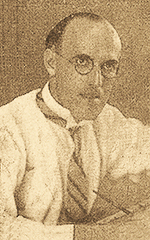
Throughout the British Empire the term “only in the colonies” was used to describe a situation that depended on a certain relaxation of rules and practices – a bit like playing tennis with the net down.
As it applied to Arthur Emlyn, only in the colonies could an accountant without a university education have risen to become chairman of an important company. It never could never have happened in class-conscious Britain.
He was born Arthur Emlyn Jones (he never used his full name) in London on 31st August, 1891 of Welsh ancestry and educated at Dame Alice Owen’s School in Islington. Showing an early gift for figures, he served as paymaster in the British navy during WWI. After the war he went to work at the accounting firm of George A. Touche Co., a forerunner of today’s Deloitte & Touche.
On 2nd May, 1919 opportunity came calling. The London office of Dr. J.G.B. Siegert & Sons Ltd, the maker of Angostura Bitters, offered him a job at its headquarters in Trinidad. It didn’t take him long to tidy up his affairs and get on a boat. He and his wife, Rosalind, arrived in Port of Spain on 22nd June – a mere forty days later. As he sized up his new situation he asked himself a question that was on the mind of many a young man arriving in the colony: “What can Trinidad do for me?”
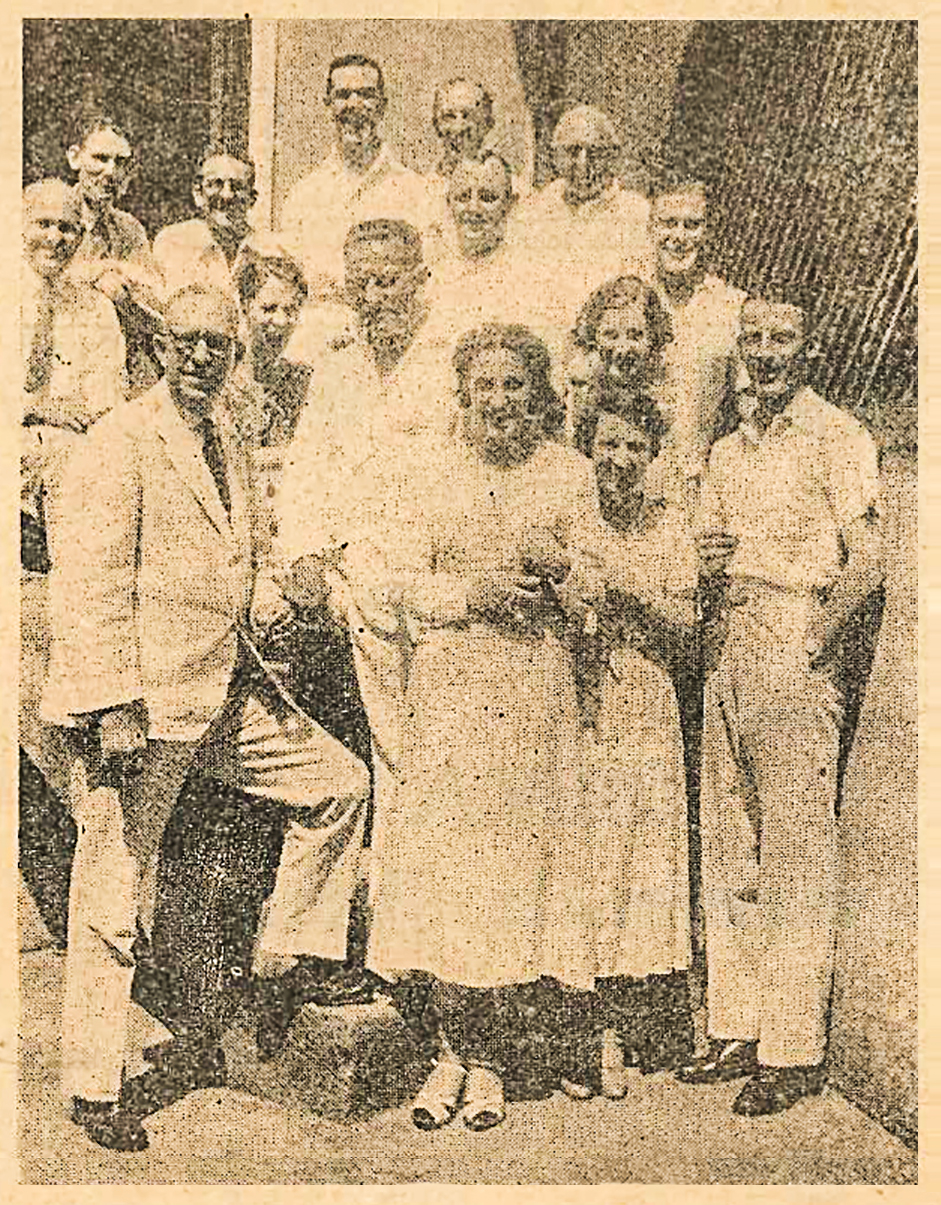
From the TRINIDAD GUARDIAN, 8th December, 1940.
When Lady Young arrived two decades later, Arthur had made himself an indispensable part of Trinidad’s social and commercial apparatus. A partial resumé as of 1939 read like this:
• Organist at St. Ann’s Church of Scotland on Charlotte St.
• “Worshipful Master” of the Masonic Order at Royal Prince of Wales Lodge on Alexandra St.
• Honorary consul general for Norway.
• President of the Trinidad Chamber of Commerce.
• Director (later chairman) of Angostura Ltd.
• Mainstay of the theatrical society known as the Trinidad Dramatic Club.
Although it was all on an amateur basis, his work with the Trinidad Dramatic Club showed the mild mannered accountant in another light – a “comic genius” (according to the GUARDIAN) who approached his roles with the “utmost vigour and audacity”. He carefully put his press clippings into a scrapbook and kept it with him for the rest of his life. The photo at right shows the all-white cast of “Lucky Dip” which premiered in January 1934. It was a drawing room farce in which a group of mismatched strangers (Mr. Emlyn played a cat burglar and his wife a Cockney shopkeeper) get together for a meal. You could say that the play was a metaphor for British Trinidad in general and the farce that was crown colony government.
On the real estate front Mr. Emlyn bought “Le Chalet”, an estate on Long Circular Road formerly owned by Thomas Davidson Arnott. Again, he never would have been able to afford anything like it in London. In a fit of nostalgia he changed the name of the property to “Bryntêg”, after a scenic area in North Wales. To get around town he imported a Morris-Cowley automobile, a sporty two-seater with a squeeze-bulb horn.
Somehow he found time to take on the position of colony director of the Red Cross, a post he held for 9½ years. In that capacity he was present at the tension-filled meeting at Government House on 9th Nov. 1939 and supported Lady Young in her attacks on Mrs. Simpson. At the meeting he recounted his two phone conversations with Mrs. Simpson that put her at odds with the Red Cross and prompted her to start her own sewing guild.
* * *
Unlike many of the Red Cross committee members who left Trinidad in the 1950’s, Emlyn stayed on after Trinidad gained independence and more honours came his way – directorships in the Trinidad Publishing Company, Trinidad Lake Asphalt Co., Queens Park Hotel and, to top it off, an OBE “for public services”. It seemed that he adjusted nicely to the principle of majority rule.
Then came the Black Power riots of 21st April 1970. The PNM was one thing; mobs in the street was another. Emlyn wrote in his diary that day: “state of emergency in Trinidad (riots etc.)”. The Emlyns left as quickly as they came. On 3rd May Rosalind Emlyn flew to England and Arthur left a few days after that by boat. By September they had purchased a home in Bournemouth, England with a view of the ocean.
The repatriation of the Emlyns, after fifty-one years in Trinidad, was probably a more difficult adjustment for them than their expatriation. At an advanced age they, and many others like them, had to return to a cold climate without any servants to wait on them. As Sathnam Sangeera put it in Empireland (2023), “This was problematic for many as they had lost any knowledge of how to do even the most basic of household tasks, such as lighting a fire.”
Mr. Emlyn did not burn his bridges entirely. In the fall of 1972 he returned to Port of Spain to be with his Masonic brothers and celebrate the centenary of the Royal Prince of Wales Lodge which took place on 28th October. He left Trinidad for the last time on 5th December and died in Bournemouth on 19th February 1973 at the age of eighty-one.
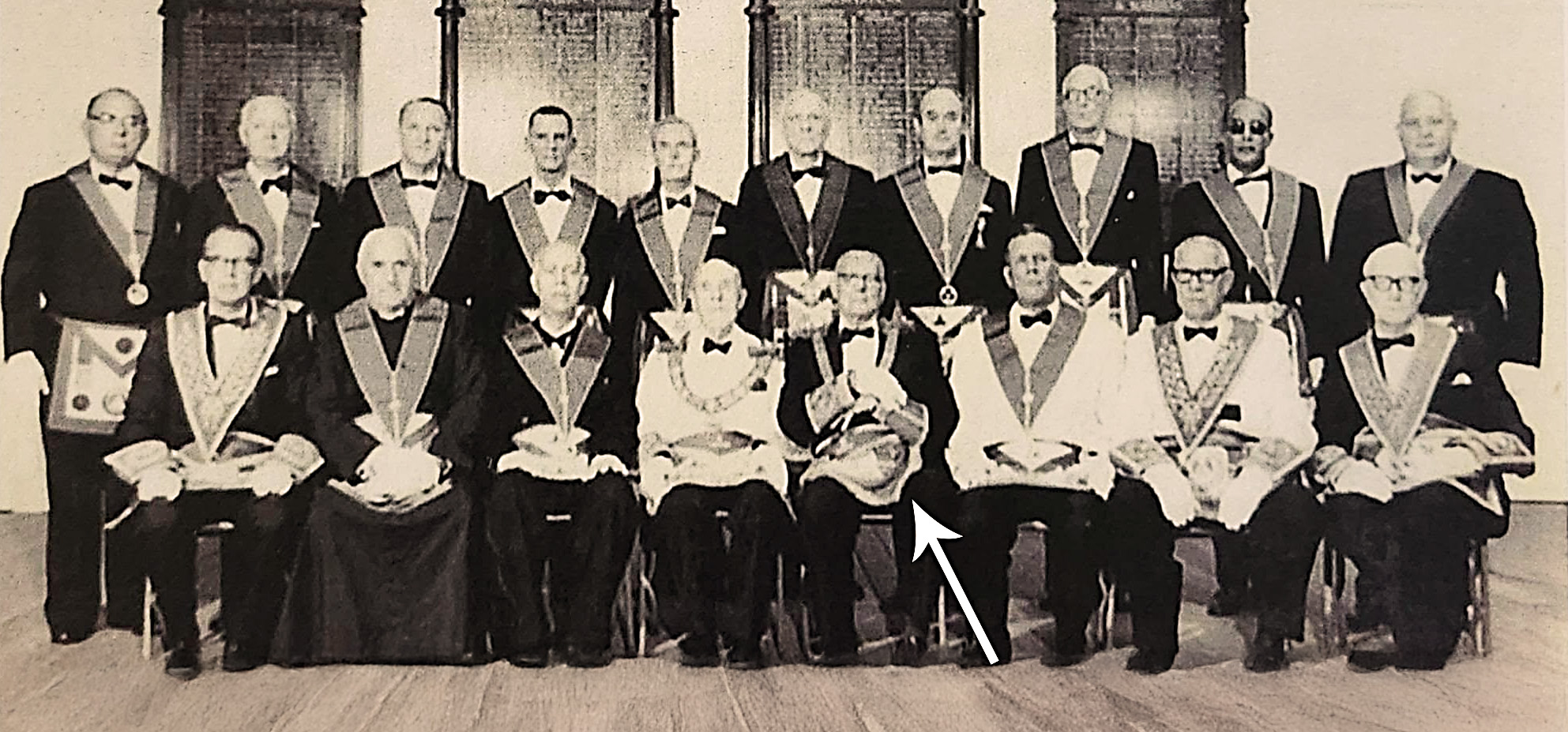
2. F.P.L. Derriman (treasurer)
Francis Philip Louis Derriman (1901-1977) was a career civil servant in the Colonial Audit Service. He arrived in Trinidad in June, 1938, the same month as Governor and Lady Young, and was later joined by his wife, Dorothy. As indicated, he served as the treasurer of the Red Cross. On 1st July, 1945 he left Trinidad to take a position as director of audit in Sierra Leone. In 1952, on the occasion of the queen's birthday, he was appointed to the civil division of the Most Excellent Order of the British Empire (OBE). He retired to the upscale Sloane Avenue neighborhood of London and he died there on 2 April, 1977.
3. Dr. Robertson, Caroni Estate, Waterloo
Alexander Brown Robertson was born in Kilmarnock, Scotland on 29th December, 1884 and received his training as an engineer at Kilmarnock Academy and Glasgow Technical College. He was not a medical doctor or a doctor of anything – one of the many mistakes in the list. He worked in the sugar industry in Mozambique and Jamaica before taking a position in 1920 as the chief engineer at Waterloo Sugar Estates Ltd. in Carapichaima.
In 1922 he applied to become a member of the British Institution of Mechanical Engineers and, avoiding any chance of understatement, described his “degree of personal responsibility” at Waterloo this way:
“Full charge of Leaching, Distillery & Transportation H.S. of Boilers 29,000.
Machinery: Mill Compound Gearing, Mill Engines, carriers, Pumps, Evaporator Quad. effect, Vacuum Fans, Crystallizers, Centrifugals, Vacuum Pumps, Cold water Centrif., Pumps [lots of pumps!] Heaters, Clarifiers, Fillers, 7 Locomotives, 200 Cane Trucks, 30 Miles Railway.”
His application was approved.
In 1937 the Waterloo Estate was acquired by Caroni, Ltd., a subsidiary of the conglomerate Tate & Lyle, but Robertson stayed on as chief engineer. Shortly after being named to the Red Cross committee he suffered a work-related injury that was not properly treated and it led to his death on 10th November, 1939 at the young age of fifty-four, leaving his wife, Williamina (Montgomerie), also from Scotland, and a teenage daughter, Jessie, who was probably born in Trinidad.
After her husband's death Williamina moved to an apartment at the Queen's Park Hotel. It was a logical choice for her because her late husband had designed the mechanical systems for the building when it was rebuilt in 1937. Williamina visited Scotland from time to time but kept Trinidad as her place of principal residence for the rest of her life. In 1966 she traveled to Birmingham, England, probably for medical treatment, and died there in hospital on 2nd August, 1966 at the age of eighty.
4. Dr. R.J. Krogh, Usine Ste. Madeleine, San Fernando
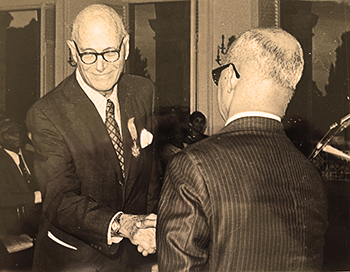
Among the tiny clique of white Europeans who regarded Trinidad as a Land of Opportunity, no one embodied the rewards and requirements of colonialism more than Robert Joseph "Roy" Krogh.
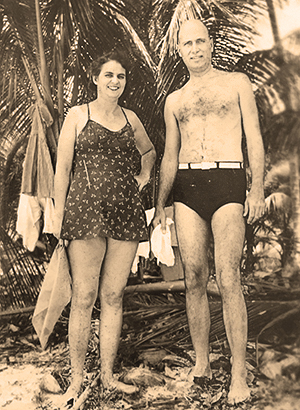
Dr. Krogh (1904-1980) was a "two boat" immigrant, that is, his Danish ancestors emigrated first to another country, in this case Venezuela, around 1840 and set up shop in the port city of Ciudad Bolivar (formerly Angostura). Port of Spain was a major point of transshipment for goods (cattle, timber, aromatic bitters) going out of Ciudad Bolivar and the Kroghs went along for the ride, eventually relocating to Trinidad and marrying into the families of French land owners, first the Selliers and then the Blancs and d’Abadies.
Roy grew up at “Candelaria”, the cocoa estate owned by his mother’s family in north central Trinidad on land that was turned into a U.S. Army air base (Waller Field) during World War II. He received his training as a doctor and surgical specialist in England at the University of Bristol. At the time of his appointment to the Red Cross committee he was the chief medical officer of the Ste. Madeleine Sugar Company while maintaining a busy private practice in San Fernando.
In 1931 he married Germaine Marie d’Abadie whose family owned the San Pedro estate in central Trinidad. Marriages of this period tended to pair land-rich, cash-poor families with infusions of new money on the other side.
Near the end of his life Dr. Krogh received many awards for his service to Trinidad in the field of medicine including the Hummingbird Medal (gold). In the above photo he is receiving the Public Service Medal of Merit of the Order of the Trinity from Prime Minister Eric Williams.
Recently the Krogh residence on North Rd. in San Fernando was nominated for placement on the register of historic sites by the National Trust of Trinidad and Tobago.
5. Dr. M. Schwartz, Trinidad Leaseholds, Pointe-a-Pierre
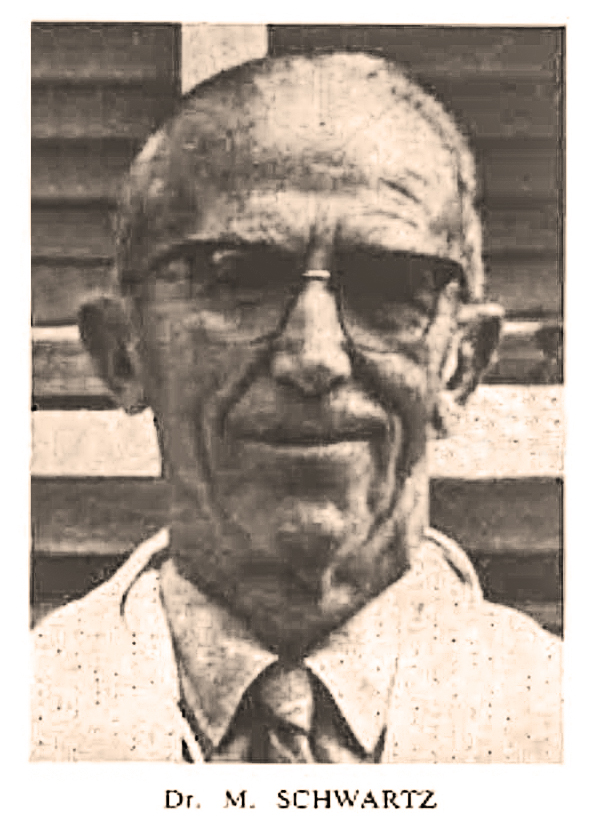
When Morris Schwartz arrived in Trinidad in 1929 there were fewer than ten Jews on the island. Was his minority status a concern for him? Probably not. He had practiced medicine in the far corners of the British Empire where Jews were few and far between – places like North Borneo, Kenya, and Tanganyika (Tanzania). Also he could take comfort in his new job – chief medical officer of Trinidad’s largest oil company.
* * *
In 1938 the profile of the Jewish community in Trinidad changed dramatically. As Jews fled Nazi Germany in a panic, the British West Indies became a last resort destination because of its “no visa” policy – anyone with a valid passport could enter Trinidad and stay there. By early 1939 there were about 500 destitute Jews, some of them highly trained, scrounging for anything they could get in Port of Spain. This influx was like nothing that had come before – usually white people arrived in Trinidad on a glide path, as self-funded missionaries or pre-selected captains of industry – like Dr. Schwartz.
On Feb 19, 1939 the Sunday Guardian took the measure of this new phenomenon in the following way:
“Even in Trinidad there are a number of Jewish professional men and women, lawyers, doctors, a university teacher, journalists of good standing, artists . . . One of the physicians, a lady doctor is now a midwife, another turned chemist and a third one is a foreman in a local factory. A famous master-builder of Vienna is now looking for any kind of work. His wife makes a living by tailoring.”
The new workforce produced a backlash among rank-and-file Trinidadians, based not so much on anti-semitism as a sense of powerlessness, as expressed in the 1939 calypso song, “The Jews’ Immigration,” by King Radio:
“We form no objection to the Jewish immigration,
But we want representation.
We had all agreed and received a few,
But to come in by the thousand that wouldn’t do . . .
Like Trinidad is the dumping ground.
The place is so congested, friends, I must say,
Yet the foreigners are pouring in every day.
So I disagree – that shouldn’t be in a small little Colony.”
King Radio’s song was promptly banned as were others of a similar nature. Why? – the British were trying to pretend that the welcome mat was extended to all refugees from Nazi Germany in order to claim a propaganda victory over Hitler. The reality was far different.
That was the bitter works of colonialism – Trinidadians like King Radio had no access to elective representation that might have affected public policy and when they expressed themselves through other means (calypso), they were banned and censored.
* * *
To what extent was Morris Schwartz involved in “The Jewish Question” in Trinidad? Apparently not much. There was no mention of him in published accounts, nor was he listed on the masthead of any Jewish organisation – but he may have worked with Jewish refugees behind the scenes, based on one fascinating hint. His obituary in the British Medical Journal stated that he advocated the practice of midwifery, which was not typically something you would see on a doctor’s resumé. Could his interest in midwifery have brought him into contact with the “lady doctor” mentioned above by the Guardian?
Dr. Schwartz left Trinidad in 1952 and returned to South Africa. The following year, in Johannesburg, he married a Barbadian woman named Miriam Eileen Browne who was raised in Trinidad. They must have known each other in Trinidad. It was the first marriage for both.
The newlyweds moved to Nyasaland (Malawi) and then to Bulawayo, Rhodesia (Zimbabwe) where Dr. Schwartz continued his medical practice. There he found a large and active Jewish community, but once again a British Crown Colony proved to be a shaky fortress where the Jews were concerned. In 1965 the white minority government of Ian Smith declared independence from Britain and that brought on international sanctions and a Black nationalist insurgency that caused the majority of Jews to leave Rhodesia, mostly for Israel and South Africa.
The Schwartzes bucked the trend. They hung on in Bulawayo and Dr. Schwartz died there of natural causes on 10th March, 1968.
* * *
For further study the reader is directed to “Nearly the New World: The British West Indies and the Flight From Nazism, 1933-1945” (2019) by Joanna Newman.
6. Dr. Wardill, Palo Seco
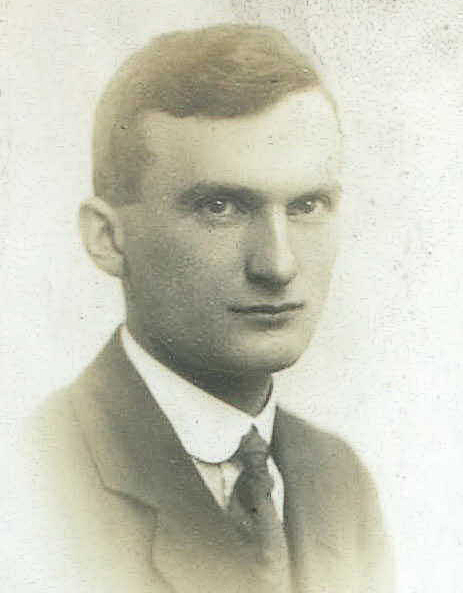
Thomas Edwin Mandall Wardill was born in Gateshead-on-Tyne, England on 10th May 1901 and received his medical education at the University of Durham, graduating with an M.B. degree in 1933. He arrived in Trinidad with his wife, Susan, and two sons in March, 1939 to take charge of the “medical and welfare office” at Trinidad Petroleum Development Co. Ltd.
In 1948 Dr. Wardill made an ill-fated career move. He left Trinidad to take a position at the Anglo-Iranian Oil Co.in Abadan, Iran, one of the hottest inhabited places on the planet. The refinery there – the largest in the world at the time – was 51% owned by British Petroleum. In 1951 Abadan became even more inhospitable when the oil company was nationalised and the British expelled by the government of Mohammad Mossadegh. Wardill explored job opportunities in Nigeria for a time and then returned to Britain.
Although in his fifties by then, he was still in search of other climes and moved with his wife to New Zealand. He died in Hamilton, New Zealand on 10th January 1996.
Below is an interesting glimpse of field medicine in Trinidad as practised by Dr. Wardill. It appeared in the British Medical Journal in 1947. Caution – it is not for the squeamish!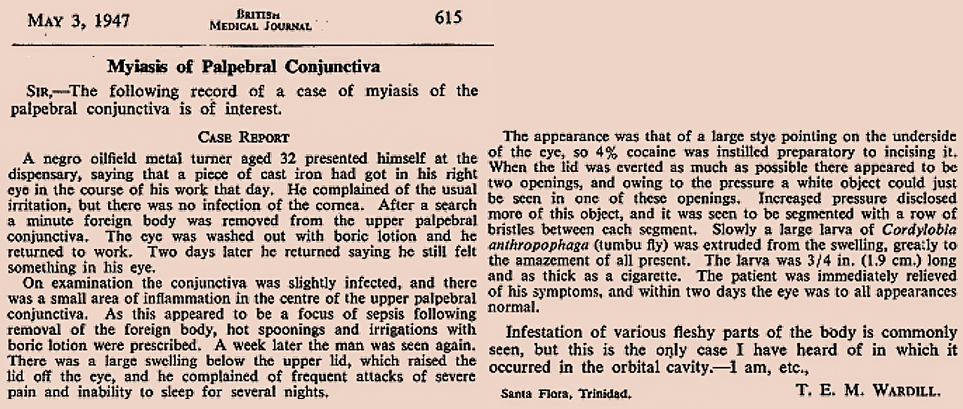
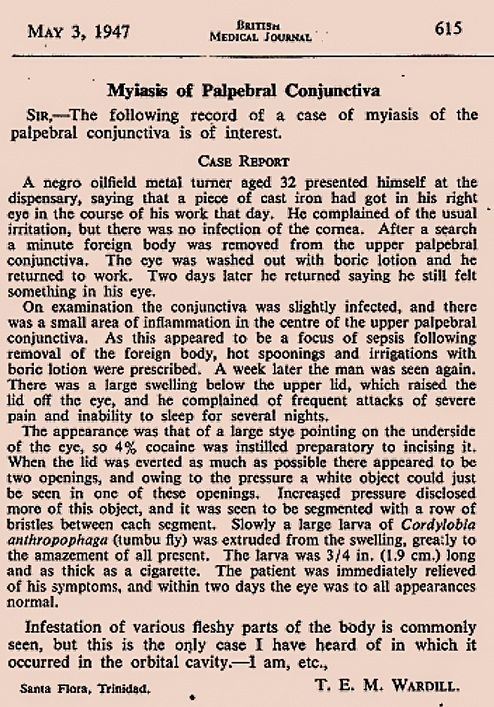
One of the takeaways from this vignette is that the patient was fibbing when he said his eye problem was work related. Reading between the lines one can see that the “negro metal turner” (lathe operator) received excellent care on each of his four visits to the dispensary.
Taking this account together with the “studies” of Dr. Earle (see below) one can argue that the oilfield workers received a higher level of care than the general population. In fact, health care was a bargaining chip in the tense standoff between labour and management in the period after the Butler riots of 1937.
7. Dr. Littlepage, Apex (Trinidad) Oilfields Ltd., Siparia Post Office
Among the members of the Red Cross committee Dr. Stanley Esmond Littlepage (1907-1977) was the only link to the founding families of English-speaking Trinidad and its slave-holding past.
He was the great great-grandson of John Burnley Littlepage, a Virginian who arrived in Trinidad as a teenager in 1799. What drew him to Trinidad was probably the recommendation of his cousin, William Hardin Burnley, who had visited the island a year earlier. What Burnley and Littlepage saw there quickened their pulse – a chance to enrich themselves by exploiting a very sketchy form of government based on a poorly understood (was it OK to torture your slaves?) Spanish legal system. The result was high levels of insider dealing and weak legal controls.
Adding a new page to this book, the two cousins connived with the oidor (chief justice), a man named George Smith, to be appointed depositarios – officers of the court who acted as receivers of property undergoing probation or litigation. The monies flowing through their office, according to later audits, never reached the intended recipients, instead ending up in the pockets of the depositarios. A member of the governor's advisory council, John Black, described the operation this way in a letter written in 1810 to a British parliamentarian:
“Smith's ambition is to throw into the hands of Burnley all the property he can, either from the deaths of the propietors, or from claims of creditors; and that the revenues shall be by Burnley (after having had good pickings out of them!) . . . and in a short time, by the Judge's pleasure, Burnley will have a million and a half dollars through deceased estates alone, for which he has not given any real security.”
(For more on this see “The Slave Master of Trinidad: William Hardin Burnley and the Nineteenth-Century Atlantic World” by Selwyn R. Cudjoe.)
Somehow Burnley and Littlepage were never held to account for their theft or forced to make restitution. Instead, much of the money went to acquire slaves – but the two cousins took different paths. Burnley (1780-1850) became the largest slave owner in Trinidad and, naturally, the richest man on the island, owning eight sugar estates outright and holding mortgages on several more*. Littlepage (1780-1846) never owned more than a few dozen slaves and they were apparently put to work on construction projects in Port of Spain. Around 1813, for example, a company headed by Littlepage was contracted to build a wall around Lapeyrouse Cemetery that was almost certainly built with slave labour.
What Littlepage lacked in quantity of slaves he made up for in quality because of a favourable coincidence: he had married into the family of Dr. Alexander Williams whose job it was to give every enslaved person arriving in the colony a physical exam.
After the abolition of slavery in 1834 the British government paid to J.B. Littlepage as compensation for the loss of his property (49 slaves held by him, his wife, and his father-in-law's estate) a total of £1,795 – equivalent to US$275,000 in 2025. (source: ucl.ac.uk/lbs/person/view/44725) Later on some of that money may have gone to pay for Stanley Littlepage’s medical education.
Speaking of medical education Stanley Littlepage received a “diploma of licentiate” (LRCP) from the Royal College of Physicians in 1936. This degree was popular with colonials because it allowed them to return home at a young age with a license to practice medicine. The LRCP has since been discontinued. In taking up his duties at Apex Oil he was noticeably undertrained compared to his colleagues Schwartz and Earle who had advanced degrees in tropical medicine.
Dr. Littlepage married Mary Olga Cadiz in 1936 and they had a large family which accounts for the many Littlepages in Trinidad today. Mrs. Littlepage lived to be 101 and died in 2013.
* At his death Burnley owned the following sugar estates: Orange Grove, Endeavour, Petersfield, Providence, Esperanza, Phoenix Park, Mon Plaisir, and Perseverance.
8. Dr. V. Earle UBOT, Point Fortin
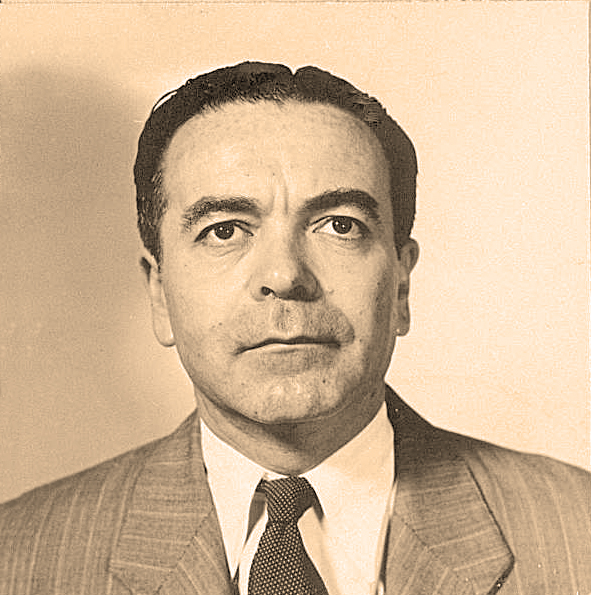
This was Kevin Vigors Earle, chief medical officer, United British Oilfields, Trinidad (UBOT). He was born in the Isles of Scilly, off the coast of Cornwall, in 1907. Throughout his life he downplayed his first name in favor of Vigors which had deep roots in the landed gentry of Ireland. On travel documents he gave his ethnicity as “Irish.”
Dr. Earle received an M.D. degree from Univ. of London in 1935 and completed his residency in Barbados. His surroundings seemed to agree with him and he spent the rest of his life as a globe-trotting specialist in tropical medicine.
He moved on to Tinidad in 1937 and found himself in the thick of the labour unrest that rocked the oilfields in June – fourteen people killed in the rioting. Exactly where he was when people were being shot and burned to death is not known, but he was not deterred from taking up his post at UBOT.
His job there was to act as a gatekeeper to employment by rejecting applicants who showed symptoms of vitamin deficiency (avitaminosis) which was rampant on the island. As he later explained: “the worker who suffers from avitaminosis obviously cannot be very efficient; he readily falls sick and has to be looked after . . . ”
Even more dangerous, from his point of view, was the fraudster with a pre-existing condition:
“A small proportion of men, though sick, may be driven by lack of money or a nagging wife to seek work; a still smaller proportion with gross lesions may try to slip by what they think may be a cursory examination in the hope of being able to advance fraudulent compensation claims later. ”
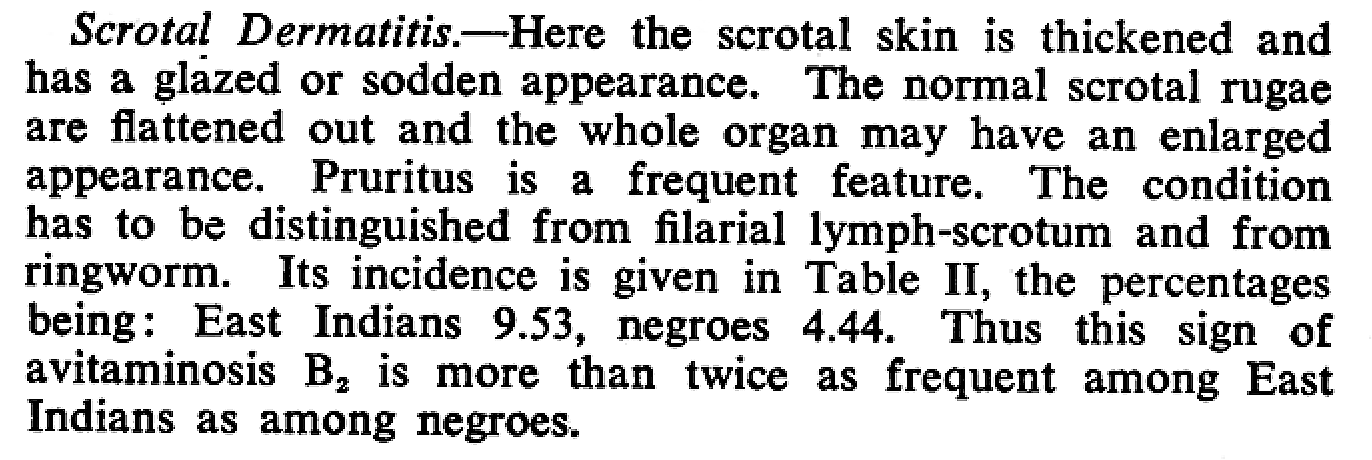
Dr. Earle's solution to the problem was to subject each applicant to a brutally invasive physical exam that involved, among other things, a meticulous examination of the man's scrotum – a flabby scrotum being a sure sign of vitamin B2 (riboflavin) deficiency, according to Dr. Earle, as put forth in his medical jargon (at right).
During his time at UBOT (no more than four years) Dr. Earle examined 1011 job seekers – an extremely high number when you think about it. The entire oil industry employed only 9000 workers and UBOT was one of the smaller companies. It spoke to the structural problem of Trinidad's economy – its main industry did not really require that many workers.
He kept a careful breakdown of the men coming before him – 820 Africans, 168 Indians, 7 Chinese and 16 “mixed creoles”. As for the white men seeking employment at UBOT, apparently they did not have to pull down their pants and have their private parts palpated. It was a naked example of the racial divide in Trinidad.
In 1941 Dr. Earle submitted his carefully assembled statistical analysis to the University of Cambridge and on the basis of that was awarded a master's degree that helped to promote his reputation as an authority on tropical medicine. In that same year the labour market in Trinidad was turned upside-down by the arrival of U.S. military forces. Over 25,000 Trinidadian men, their reproductive glands carefully concealed, marched to good-paying jobs at the new air and naval bases.
Dr. Earle left Trinidad in 1942 and took a job with a much bigger oil company, ESSO, where he was given the position of physican-at-large, a kind of medical trouble shooter. He spent the rest of his life at or near the equator – Ecuador, Sierra Leone, Micronesia. He died in 1985 and was probably still living abroad because he gave his legal address as 1 Wimpole St. London which was the headquarters of the Royal Society of Medicine.
9. Mrs. Morley, 39 Mucurapo Road, Port of Spain
If I could travel back in time to speak with one person on the Red Cross committee it would be Mrs. Morley – because she didn’t fit in. In astrological terms she was a planet wandering into a fixed constellation and then, just as abruptly, leaving it behind.
She was born Lucy Lyddon Roberts in the fashionable Dulwich section of London on 10th December, 1909 which made her, at the age of twenty-nine, the youngest person (by a good margin) on the committee. Her father, Philip Lyddon Roberts, was a noted publisher and author. In the mid 1930’s she married Leonard Alfred Morley (1894-1978), a WWI vet who was fifteen years her senior. He was a traveling “process engraver” which meant he went from place to place (Singapore, India) making negative impressions of artwork (anything that could not be typeset) for reproduction.
The Morleys arrived in Trinidad in January, 1939, presumably for Leonard to take up his process work. (Details on that are lacking.) Lucy quickly took on a senior position in the newly formed Red Cross, so she must have had a nursing degree or some equivalent training. She was put in charge of a special “detachment” of women, forty-seven in all, who had qualified for a certificate in first aid and “home nursing.” She was even given a title: “Commandant”. Her prominence in the Red Cross must have been occasioned by the scarcity of white women willing to work as nurses in Trinidad.
Then in September 1939, barely two months into her new job, she and her husband left Trinidad and as far as we call tell, never returned. Whether this came as a surprise to Lady Young is not known. Her position at the Red Cross was taken over by Vera Muller, the wife of W. A. Muller (number 15 on the list).
After leaving Trinidad the Morleys moved back to England, first to London and then to a seaside location in West Sussex. In 1966 Lucy passed away in hospital in Chichester, Sussex, England.
10. Mr. V. B. Walls, Naparima College, San Fernando
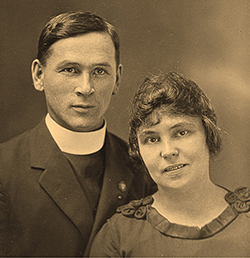
Marion Smith Walls, 1924
Of all the people on the list no one brought as much symbolic value to Lady Young's Red Cross as Rev. (not Mr!) Victor B. Walls (1892-1984). Prior to Lady Young's arrival in Trinidad, Rev. Walls and his wife Marion, using Naparima College as their institutional base, had created a Red Cross style relief operation that included an ambulance corps and infirmary. Mrs. Walls compiled and published a textbook on first aid practices, adapted for a tropical climate. She also coordinated her efforts with the Canadian Red Cross.
How the Wallses felt about being crowded out by Lady Young and absorbed into the British Red Cross remains unknown. They may have welcomed it. They were both extremely busy at Naparima. In any case, their cooperation with Lady Young was vital to the early acceptance of the Red Cross in Trinidad. The relationship between Lady Young and Mrs. Walls was particularly delicate. They were both Australian by birth, and Marion was part aborigine.
Victor Benjamin Walls was born in Blackville, New Brunswick, Canada on 23 June 1892, of Scotch ancestry – his wife, the former Marion Smith, a year earlier in Sydney, Australia. They met on the battlefields of World War I – he in the Canadian Army Medical Corps, she as a British army nurse. As first-responders they gained a tremendous amount of medical knowledge.
The Wallses were married in New Brunswick on January 1, 1924 and that same month they departed for Trinidad after Rev. Walls accepted a position as principal of Naparima College which was run by the Canadian Presbyterian mission. Rev. Walls kept his position at Naparima until 1952 and is generally credited, along with his wife, with securing the preeminent position of the College in Trinidad. In 1930 Mrs. Walls composed the school hymn which is still sung today:
"No matter where we roam,
If near or far from home,
Let us always be one - Naparima."
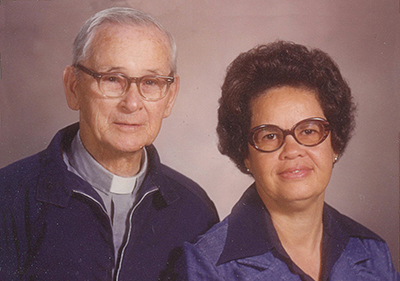
In 1953 Rev. and Mrs. Walls left Trinidad and returned to the tiny, isolated village of Blackville, New Brunswick. It was there that Marion died in 1957. Following her death Rev. Walls added a fascinating footnote to his life story when he married Verna E. Augustin, a Trinidadian woman thirty-one years his junior. The details surrounding his interest in Ms. Augustin, and vice versa, must remain unexamined for lack of information.
The newlyweds resided in Blackville where Rev. Walls had taken up ministerial duties. In 1975 he was awarded the Chaconia Gold Medal, Trinidad's highest civilian honor, but whether he made the trip south to collect it in person is not known. He died on 19 September 1984, age ninety-two, and was buried at St. Andrew’s Cemetery in Blackville.
Rev. Walls is remembered today in Trinidad chiefly for the many marriages he performed.
11. Mrs. G.H. Masson, MBE, 7 Sweet Briar Rd. Port of Spain
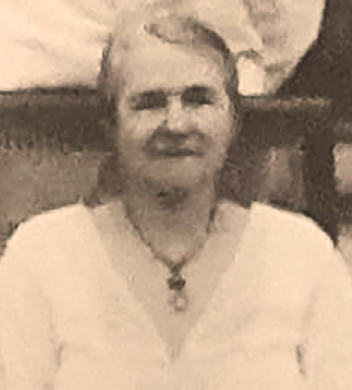
This was Jessie Innes Masson (1873-1954), a trailblazing reformer and social worker who dedicated herself to the cause of empowering women in Trinidad in the first half of the 20th century. At the age of sixty-six she was the oldest member of the Red Cross committee. Originally from Scotland, she was instrumental in the creation of the Girl Guides movement and the Coterie of Social Workers. Using the Coterie as her base she fought against restrictive laws that barred married women from the teaching profession and prohibited women under thirty from voting when men could vote at twenty-one. In June 1939 she was named a member of the Most Excellent Order of the British Empire (MBE) in recognition of “public and social services in Trinidad.”
In addition to being on the executive committee of the Red Cross, Jessie also had a staff position, in charge of organising the collection and distribution of relief supplies. In this capacity she had an early conversation with Mrs. Simpson that caused Mrs. Simpson to set her own course apart from the Red Cross. Too much red tape at the Red Cross!
Her husband was a native Trinidadian, Dr. George Henry Masson, who attracted attention throughout the British Empire as a pioneer in the treatment of tuberculosis. The Massons may have met in Edinburgh where Dr. Masson received an M.D. degree in 1897 and a D.Sc.in public health in 1907. They are buried together in Lapeyrouse Cemetery.
The Massons raised two sons, Eugene Pierre Lanarch Lockhart (“Bill”) Masson (1898-1990) and Alexander Herbert Lanarch Masson (1902- ). Both of them were born in the U.K. and had an on-again, off-again relationship to Trinidad. The address above on Sweet Briar Rd. was known as “Carradale House”, the family estate.
12. Hon. R.A. Rankine 15 Sweet Briar Rd., Port of Spain
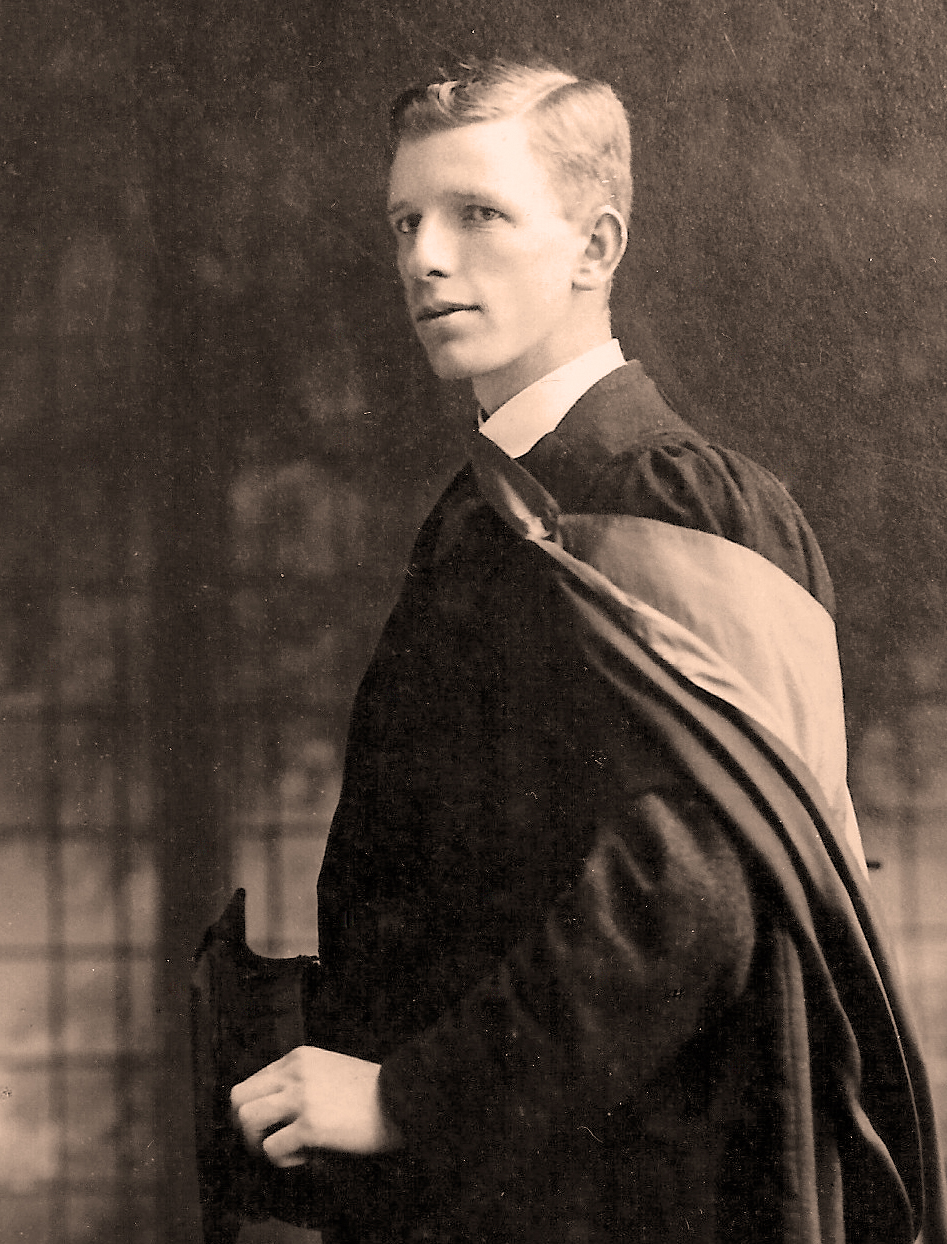
Adam “Eddie” Rankine was born in St. Boswells, Scotland in 1891 and received his M.B. and a degree in chemistry from the University of Glasgow in 1914. In the Great War he reached the rank of major in the Royal Army Medical Corps. He practiced medicine in mandatory Palestine for a while and in 1935 was appointed Trinidad’s first Director of Medical Affairs. He proceeded to rub everyone the wrong way by treating Trinidadians as if they were incapable of managing their own affairs. Also he was walking into a bureaucratic minefield that required the utmost tact, something Rankine was not known for.
It is rare for a doctor to criticize another doctor, but a native-born Trinidadian, Dr. Raoul Seheult, wrote this in a government publication called “A Survey of the Trinidad Medical Service 1814-1944”:
“Affection for the sons of the soil [i.e. native Trinidadians] and for local medical organisations was not apparently one of his [Rankine’s] many virtues; he seems to have had a penchant for those who hailed from abroad, creating suspicion of discrimination in favour of outsiders.”
Dr. Seheult went on to complain about Dr. Rankine’s disdain for the local medical apparatus:
“Attempts during his regime to alter the constitution of the Medical Board and to strip it of its powers met with determined opposition and were abandoned. His iconoclastic propensity did not end there; the Central Board of Health was another institution which was threatened with extinction. The Draft Medical Board Bill which was prepared in 1936 was pigeon-holed after many weary pilgrimages to and from Downing St., and, although it was approved by the Secretary of State, Dr. Rankine left it in cold storage and there it remains.”
When Dr. Seheult wrote this (1948), Dr. Rankine wasn’t around to defend himself. He had departed Trinidad in 1942 for a similar post in Mauritius In early 1942 Dr. Rankine was recruited by Sir Bede Clifford, the governor of Mauritius, to come to Mauritius and help in the fight against disease and malnutrition in that Indian Ocean outpost. Ironically, Rankine’s arrival in Mauritius coincided with Clifford’s reassignment from Mauritius to Trinidad, as a replacement for Governor Young. By all accounts Dr. Rankine found Mauritius less of a beaucratic thicket and gained widespread admiration for his work in public health in the tiny Indian Ocean outpost. After his retirement in 1951 he moved back to Scotland and died in Edinburgh on 24th January, 1976.
13. Hon. E.W. Daniel, The Hall, Chancery Lane, Port of Spain (asst. Director of Education)
Of all the people on the list no one achieved as much notoriety as Captain Edward Welley Daniel (1896-1952). Appointed to the hated Board of Censors in 1935, he was charged with finding and blocking any film or publication that strayed into the area of lewdness, defamation or “racial sentiment”.
In 1949 the tables were turned when scandal found him – he was charged with driving under the influence of alcohol and causing injury to a young woman! In the trial that followed the entire island was held in thrall as salacious details spilled out. Daniel's wife, Bessie, was even called to the stand to testify against him.
The following year the Growling Tiger came onstage at the Victory Calypso Tent with a song called “Daniel Must Go!”:
“The Assistant Director of Education/He found himself in confusion,
Drunk and driving his motor car/Dangerous to the public - what behaviour!
He is a disgrace to my native land/So the public should demand his resignation!”
The song caused an uproar, not because of the DUI, but because it implied the faithlessness of British civil servants generally in Trinidad. (Daniel was born and raised in London.) Ironically, "Daniel Must Go" was the very type of song that the Board of Censors was created to stifle in the first place. In the ensuing brouhaha the manager of the tent, Atilla the Hun, was arrested and charged with libel, but when the case was heard in 1951 the entire legal basis for censorship was called into question and the case was dismissed. It was an important marker in the slackening of British authority in Trinidad.
14. Maj. H. R. Hopking, MBE, St. James Barracks, POS (staff officer)
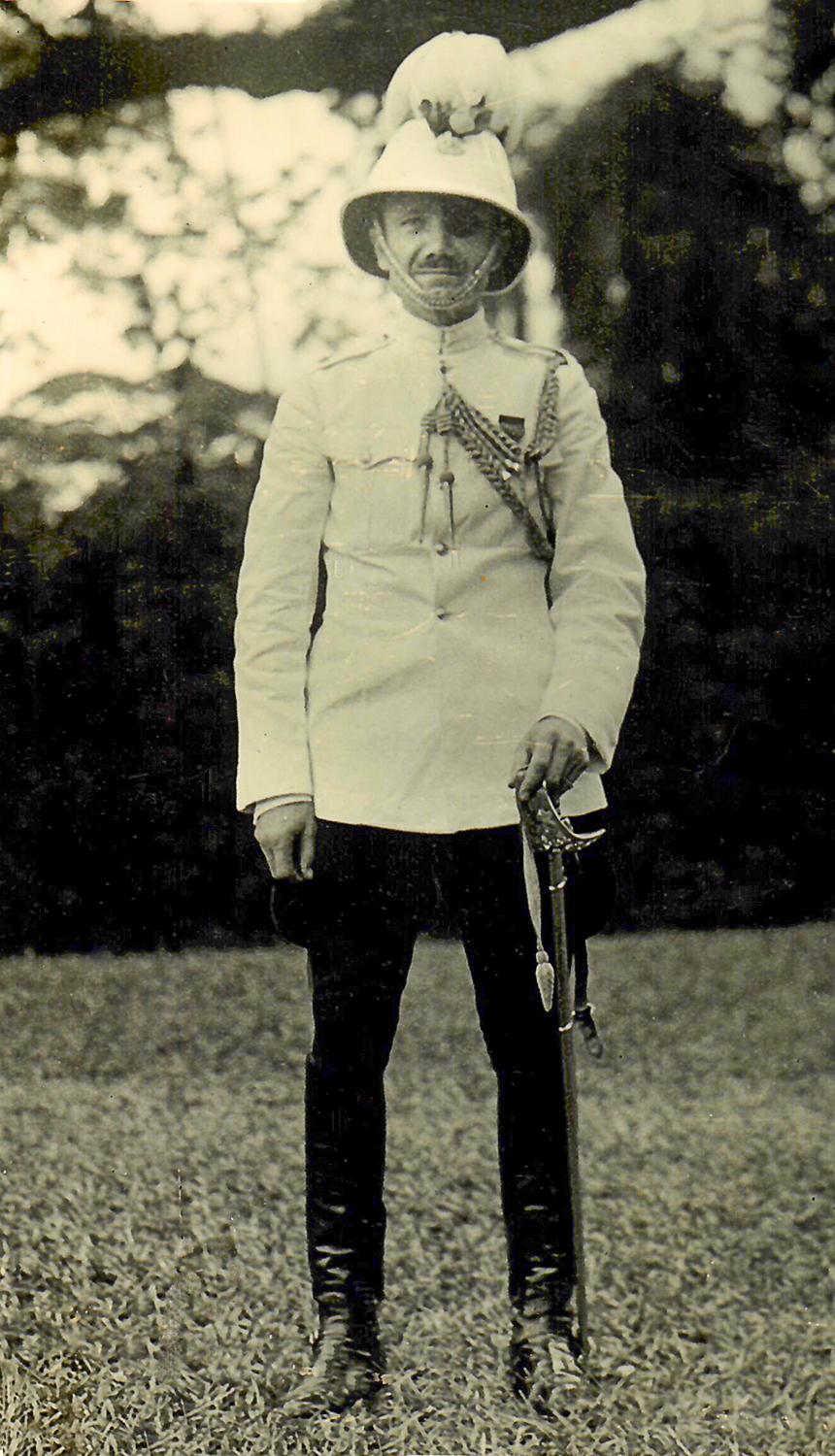
Major Henry Richard Hopking (1900-1965) was born in Dublin, Ireland. He was a career British Army officer who saw action in both world wars. In the photo at left he is wearing an eye patch over his left eye which was shot through in World War I.
He arrived in Trinidad in 1936 to take up the post of Staff Officer of Local Defence Forces. In 1937 he was one of five members of the Red Cross committee to testify before the Forster Commission in regard to the Butler riots of June, 1937. The others were, Dr. E.J. Sankeralli, Dr. Charles Deane, Arthur Emlyn, and J. H. Maingot.
When WWII broke out it became clear that Trinidad would be defended not by the British but by U.S. forces and his job became as vestigial as the wing of a flightless bird. In April, 1940 he was recalled to England and later commanded the 2nd Suffolk Regiment in the Burma campaign, eventually reaching the rank of Lt. Colonel.
He died in Suffolk, England on 16th April, 1965.
15. Col W. A. Muller, St. James Barracks, POS (Commissioner of Police)
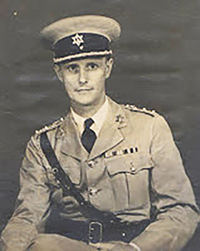
In colonial Trinidad a policeman was like a soldier in an occupying army. Just to make sure that everyone was aware of this, the British recruited its rank and file policemen from other islands like Barbados and St. Vincent, and its high command from Britain. Trinidad did not get a native-born chief of police until 1970.
The tension between the police force and the public took a gruesome turn during the labour unrest of June, 1937 - the so-called “Butler Riots”, after Uriah Butler, the head of the Oilfield Workers’ Union. On June 19 an angry mob surrounded an injured policeman, doused him with kerosene and set him ablaze. In retaliation the police shot dead twelve people.
In London, the Foreign Office responded to these events as it usually did - by appointing a commission to study the problem. At the same time they decided to take a firmer grip on the colony by bringing in officials with a proven record of dealing with troublesome natives. First came a new governor, Sir Hubert Young, who had used deadly force to suppress a strike by copper miners in Northern Rhodesia in 1935. Next was a new police commissioner, Colonel Walter Angus Muller (1898-1970). He had held a similar post in Ceylon, another Crown Colony. Both Young and Muller arrived in 1938. If there was one thing they agreed on it was that every union organiser was a “Bolshevik” in disguise. (Today the term would be “terrorist”.)
World War II brought a period of relative calm on the labour front as Trinidadians flocked to good paying jobs at U.S. military bases, but in 1947 things heated up again. On January 21 over a thousand Butlerites (Oilfield Workers Union members) descended on Port of Spain, agitating for better pay and working conditions.
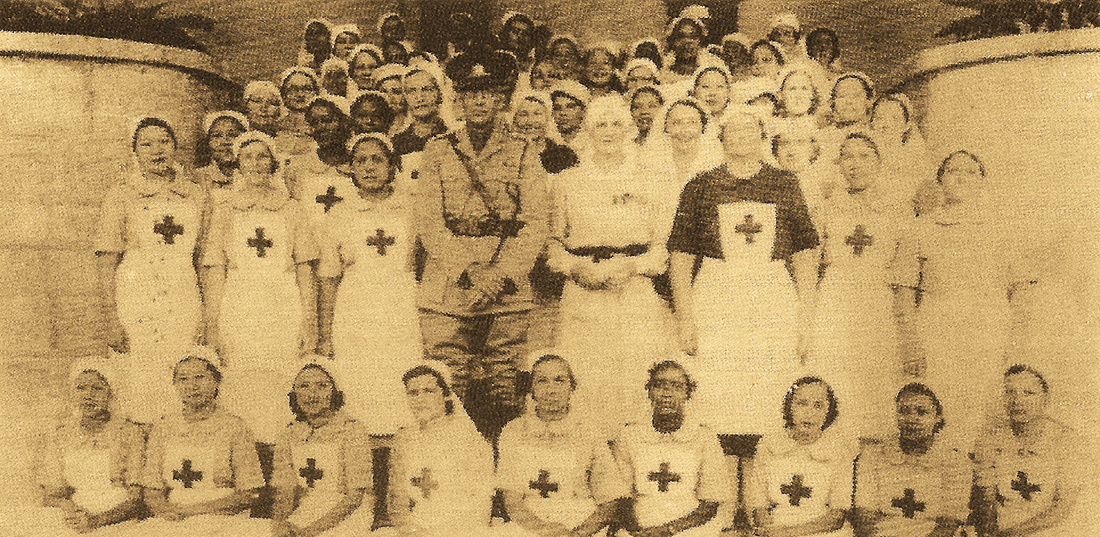 As the police tried to hold them back the crowd pelted them with rocks and bottles, one of which struck Colonel Muller in the face.
As the police tried to hold them back the crowd pelted them with rocks and bottles, one of which struck Colonel Muller in the face.
The next morning, in the wee hours, Muller had his revenge by leading a raid on union headquarters at 7A St. Joseph Rd. where many of the demonstrators were sleeping. The raid would have been totally illegal in Britain – no warrant, no evidence of a crime being committed. Muller later claimed that his purpose was “to take everybody’s name and address.” In the chaotic scene that unfolded Muller rampaged through the building waving a pistol in each hand and shouting, “Where is Butler?”, earning him the nickname “Two Gun Muller”. In the raid 348 people were arrested including 129 women. As Muller later put it, “Only a very few of the most agile and active Butlerites escaped.”
Muller was a shoo-in for the Red Cross committee and it seems that he warmed to his new role, as evidenced in this 1939 photograph where he posed with Lady Young and fifty-three Red Cross nurses. Muller was tall! Lady Young (to his right) was 5’7½” and Muller was at least six inches taller, even without his hat.
Speaking of the hat, Muller's tenure was notable for a bit of historic iconography - the placement of the Star of David insignia on the hats of all Police Force personnel. The story of the connection between the government of Trinidad and the six-pointed star is well worth seeking out.
In 1942 Col. Muller's first wife, Vera (who was active in the Red Cross), died and a year later Muller married Irene Selina O’Reilly, the sister of the famed barrister Sir Lennox O'Reilly, who counseled the Youngs in their quarrel with the Simpsons. He kept his post as Commissioner of Police until 1948 when he turned fifty years of age. In retirement he returned to Britain and died in Surrey, England in 1970.
16. Rev. C. S. Doorly, Principal of Q.R.C.
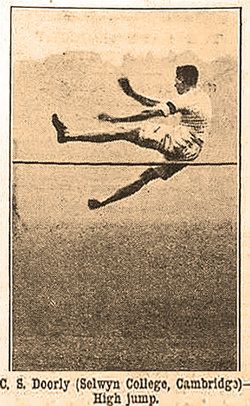
Charles Stokely Doorly (1882-1954) was born in Trinidad into a colourful and unconventional family that worked its way through the West Indies in the 19th century – Barbados, Jamaica, Guiana and Trinidad. His brother, James Gerald Stokely Doorly, was a famed mariner and polar explorer. His cousin, Martin Doorly, was the creator of “Doorly’s Fine Old Barbados Rum” which is still in circulation today. His father, the Very Reverend Wiltshire Stokely Doorly was archdeacon of the Anglican church in Trinidad.
Charles Stokely Doorly attended Queen’s Royal College beginning in 1892 when he was ten years old. In 1899 he won an island scholarship which took him to Selwyn College, Cambridge. He took holy orders in 1907 and, after curacies in the English midlands and in San Fernando returned to QRC in 1911, eventually becoming its principal in 1938. The following year he was made Canon of the Cathedral of the Holy Trinity. Canon Doorly married another Trinidadian, Lillian Alice Rooks, but the union produced no children. When Doorly died his estate was executed by his brother-in-law Henry Courtenay Rooks.
Something of an athlete, he once high-jumped 5’ 10” in a meet against Harvard and Yale, good enough for second place. For this feat he was awarded the sporting colours known as “half blue” at Cambridge. See photo at left.
17. Father Graf, acting principal of Tranquility School

Leonard Joseph Graf was born on 10th February 1883 in Aachen, Germany and studied for the priesthood in Ireland. In addition to his duties at Tranquility School, he taught at St. Mary's College for sixty years (1906-1966). In 1969 Father Graf received the Chaconia Medal (gold), the country's highest civilian honour. He died on 15th January 1970 in Port of Spain at the age of eighty-six.
18. Miss Shrewsbury, principal of Bishop’s High School for girls
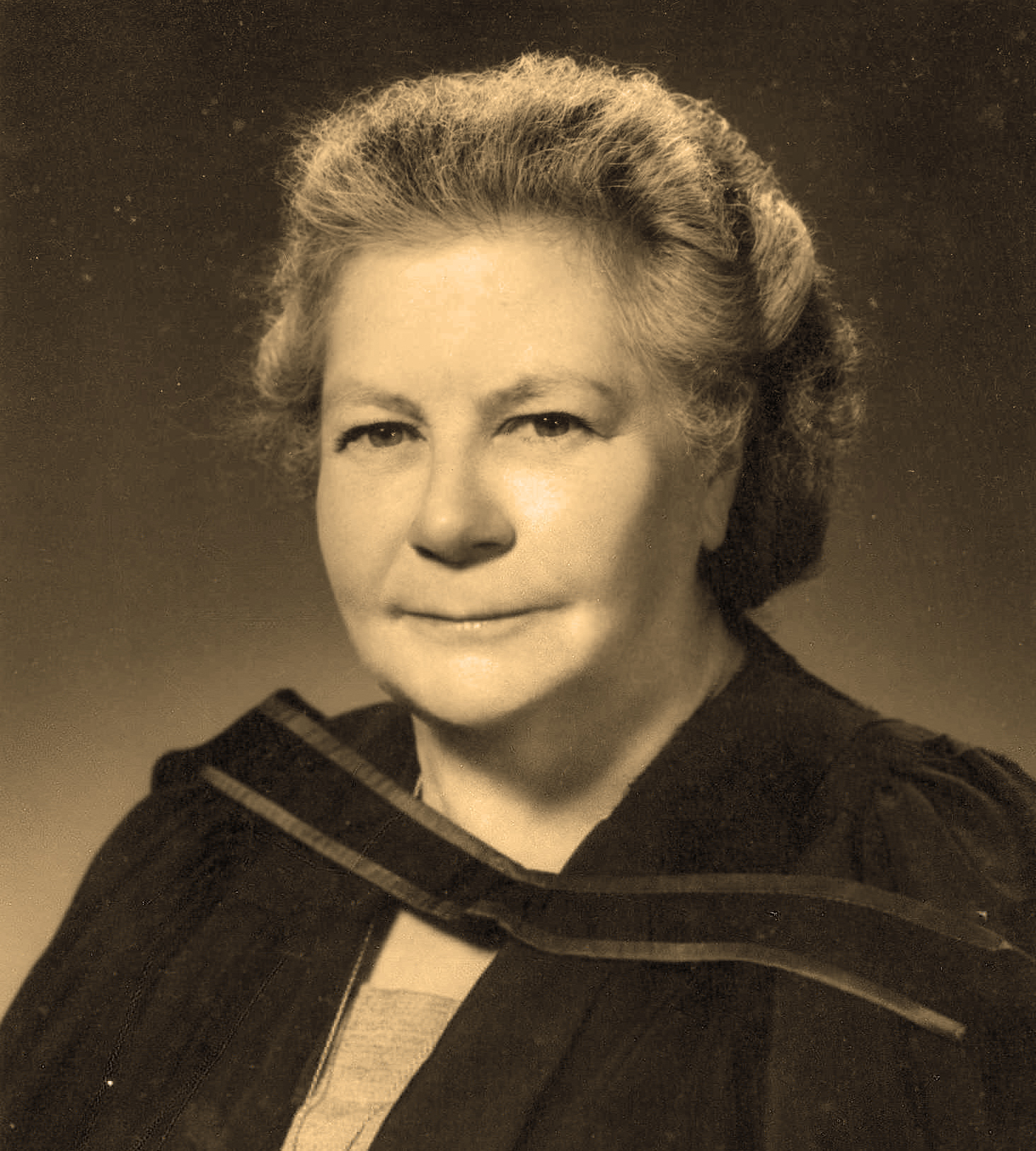
She was known as “Shrew” throughout her life, but seldom has a nickname been more misleading – in actuality Miss Shrewsbury was calm and self-effacing and she used not histrionics but gentle persuasion to achieve her goal – the education (including physical education and sex education!) of young women at a time when many people thought it was a waste of time.
Dorothy Cheverton Shrewsbury was born in Birmingham, England on 6th June 1905 and arrived in Trinidad at the age of two where her father had taken a position as government analyst. She returned to England for her education and received a B.A. in French from the University of London in 1935 and a teaching diploma the following year from Kings College London. She arrived back in Trinidad in 1938, after being offered the job as headmistress of Bishop Anstey High School, an Anglican school for girls founded in 1921. Under her leadership, instruction in the sciences was added to the school’s curriculum and programs were created for the students to take part in sports and other extra-curricular activities.At Bishop Anstey students of other religious persuasions were welcomed but all were asked to subscribe to an Anglican ethic “in order to encourage them to fulfill their true potential.” The attainment of this goal was epitomised by one of the students, Janelle Commissiong, who went on to be crowned Miss Universe in 1977, the first Black woman to be so honoured.
Miss Shrewsbury left Trinidad in 1950 and moved to Auckland, New Zealand where she had relatives. She may have felt that it was time for a native Trinidadian to take over at Bishop Anstey. In Auckland she took a position as headmistress of the Diocesan School for Girls, another Anglican institution, where she stayed until her retirement in 1965. Her death in 2001 marked the passing of the last living member of the original Red Cross committee.
19. Dr. E.J. Sankeralli, San Fernando
Esau Jymshed Sankeralli (1896-1948) was the first native Trinidadian to be appointed Director of Medical Services in Trinidad. He was educated at Queens Royal College and received his medical training in Belfast, Northern Ireland, graduating in 1924. Intending to pursue surgery as a specialty, he returned to Trinidad and joined the staff at San Fernando General Hospital, but there he found himself at odds with the surgeon general, a man named Kendrick Stanton Wise. The nature of the dispute is not known but it resulted in Dr. Sankeralli giving up his plan to be a surgeon and moving into the field of public health instead. After reaching the pinnacle of his profession - Director of Medical Services - in 1948 he died by suicide on 22nd June 1948.
Dr. Sankeralli was one of five committee members to testify before the Forster Commission regarding the causes of the 1937 “Butler riots.” The others were Arthur Emlyn, H. R. Hopking, J.H. Maingot, and Dr. Charles Deane.
20. J.H. Maingot, MC, warden of Scarborough, Tobago
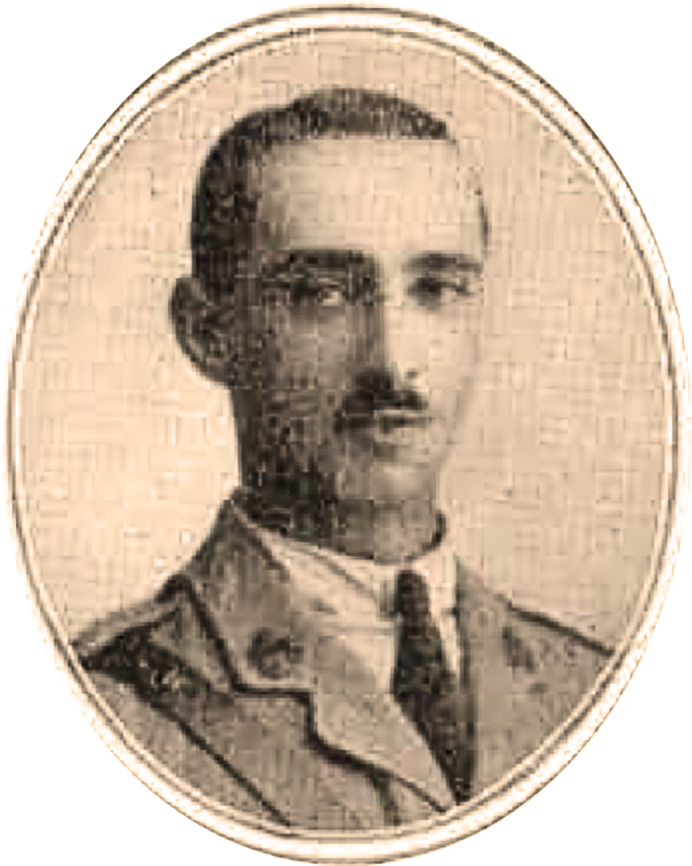
Did the executive committee of the Red Cross ever sit around and argue about who was a “real” Trinidadian? Well no – for one thing it is doubtful that the full committee ever met in one place. Most of them were put there by Lady Young simply to add prestige to the new organisation.
But if they ever did rank each other in terms of Trinidadianness, everyone would have taken a back seat to J.H. Maingot whose great, great grandfather, Joseph Etienne Maingot (1747-1821), arrived in Trinidad in 1786.
As a French Catholic J.E. Maingot was entitled to receive sixteen acres of prime agricultural land for every enslaved person he brought with him, but whether he took advantage of this diabolical arrangement is not known. It appears he was on assignment as a surveyor so perhaps he didn’t. But the point is that it was the French who developed the plantation economy of Trinidad and set the scene for the fantasy-driven carnival that survived and outlasted 165 years of British rule.
J.H. Maingot was born Henri Joseph Maingot (note the flip-flop) in 1893. In 1915, when he shipped out to join the British army, his name was anglicized to “Joseph Henry” which – war or no war – reflected the cultural shift in Trinidad in the late 19th century. This was all somewhat academic because throughout his life he was known by a nickname – “Tululu”. In the photo at left he bears a striking resemblance to another fighting Frenchman – Charles de Gaulle.
All told, at least sixteen men from Trinidad with the surname Maingot fought for the British during WWI and many of them were wounded. J.H. Maingot was awarded the Military Cross for “conspicuous gallantry”. With this kind of resumé he was a shoo-in for a government job (warden) when he returned to Trinidad.
In September 1937 Mr. Maingot was called to give testimony before the Forster Commission regarding the labour unrest and rioting as it affected the County of Caroni, so it is likely that he served as warden in that area before he was posted to Tobago in 1938.
He was married to Anna “Sheila” Hernandez who was also active in the work of the Red Cross.
21. Mrs. Frank Latour, Shirvan Park, Tobago
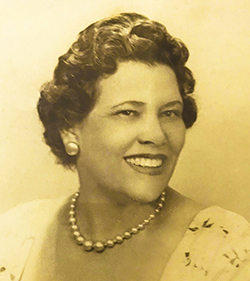
Exactly why Mrs. Latour was selected for the Red Cross committee is not known but there are a few clues:
• she was the daughter and daughter-in-law of doctors so she may have picked up some medical know-how from them. In the 1930’s Tobago was kind of a do-it-yourself place. Still is.
• she is remembered for her civic-mindedness, especially for her effort in rebuilding Tobago in the aftermath of hurricane Flora in 1963.
• There is some suggestion that she was acquainted with Lady Young prior to her arrival in Trinidad, although details are lacking.
What is known is that on the day Britain declared war on Germany - September 3, 1939 - Lady Young was in Tobago and the two of them must have shared the news. They probably talked of little else but the ramping up of the Red Cross. As one of only two Tobagonians on the committee, Mrs. Latour took on more day-to-day responsibilities than her counterparts in Trinidad.
Mrs. Latour (1904-1999) was born Kathleen Bishop and grew up in Tobago on a large agricultural holding known as Diamond Estate. Her marriage to Frank Latour marked the merger of two of Tobago’s most prominent families. Mr. Latour was the owner of Golden Grove Farm, a 700 acre estate in southwest Tobago with seaside frontage.
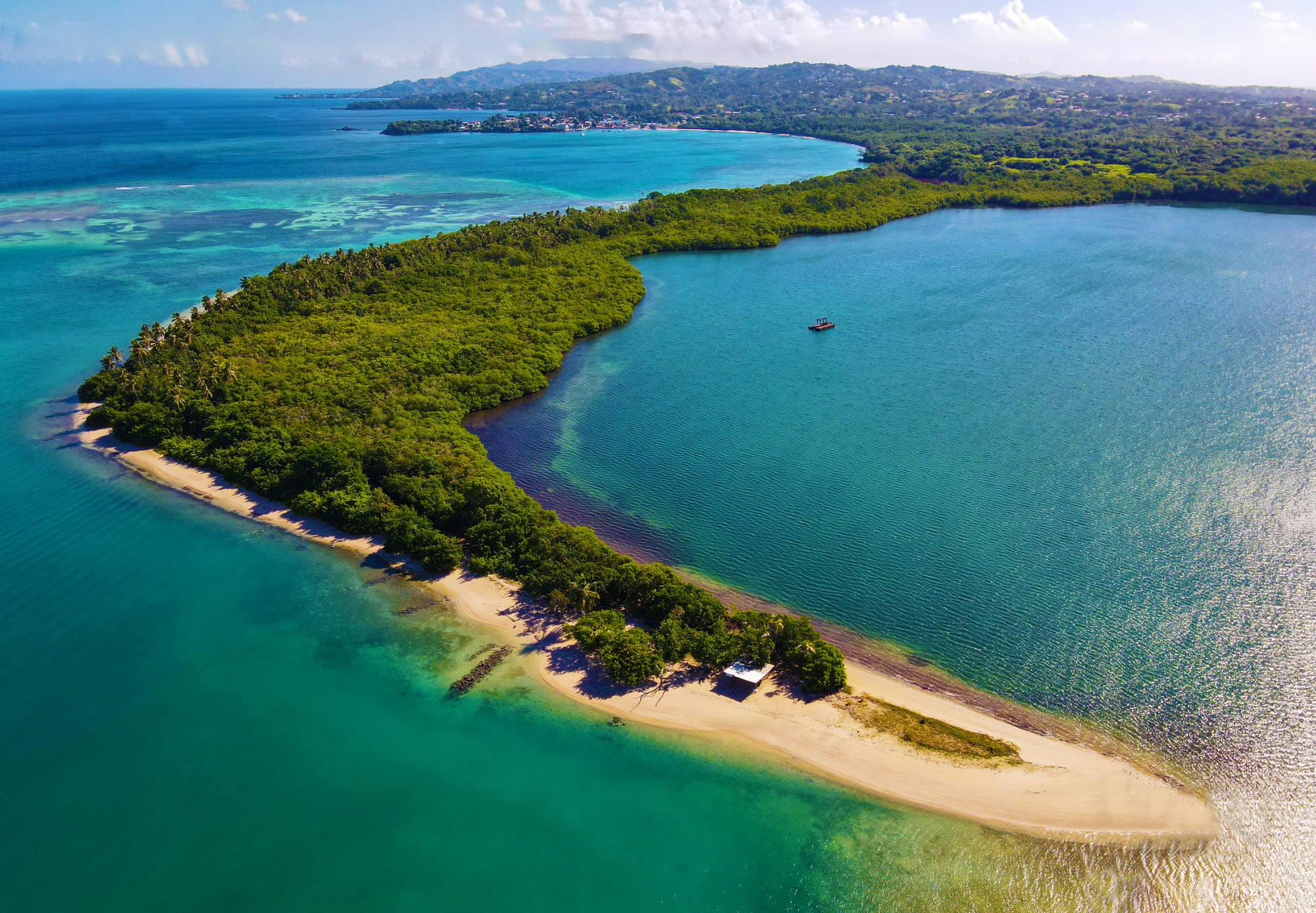
Photo courtesy of Jason X Photography
As tourism replaced agriculture as the dominant industry in Tobago, Golden Grove became immensely valuable as a scenic destination, in particular a boomerang-shaped peninsula known as No Man’s Land that was reachable only by boat. (See photo.)
In 2002, shortly after Mrs. Latour’s death, her family sold 434 acres of the Golden Grove property to Angostura Ltd., the rum and bitters company, for US $15M. A year later Angostura announced plans for a massive resort at the No Man’s Land site – two hotels, 475 residential units and an 18 hole golf course, but the project was blocked by environmentalists who were worried about damage to the nearby wetlands and reefs.
Angostura finally gave up and sold the property "at cost" in 2008. Today the area remains largely undeveloped with a few rustic bake and shark shops still reachable only by boat.
22. F.N. Brierly, warden Eastern Counties, Sangre Grande
On 14 June, 1939, as Lady Young was preparing to announce that the Red Cross was coming to Trinidad, an American anthropologist arrived in Port of Spain with the goal of making audio recordings of the music of the Shango religion. His name was Melville J. Herskovits. His project was a way, he said, of documentiong “African ways of life ... in greatest purity.”
After lugging his bulky (and balky) equipment to the remote village of Toco, Professor Herskovits found himself flummoxed by the difficulty of getting his machinery to work in the humid condition and he appealed to the local warden, a man named Frank Brierly, for help.
Herskovits and Brierly were an unlikely pair – a Jewish academic from Chicago and an Irish creole civil servant – but the two of them hit it off. They shared a concern for the social unrest in Trinidad that surfaced in bloody riots two years earlier. On 14 August Herskovits wrote in his field notes:
“Brierly turned up late in the afternoon . . . We talked for a long time after dinner; his attitude toward the blacks is of the best, and I can understand how he is liked. As a Creole (his father came to this island from Ireland) he has little patience with the attitude of some of the imported officials, and the way he told of the 1937 riots, how not only the economic element was important but the attitude of resentment against the way in which many of the oil field officials would call a man “You n–– !” in ordering him about, showed a highly realistic point of view.”
Frank Norris Brierly (or perhaps, Brierley) was born in Port of Spain in 1888, the son of John Norris Brierly who came to Trinidad as a police recruit from his native Northern Ireland in the 1870's. The elder Brierly authored a book, Trinidad Then and Now (1912), in which he described his daring deeds during the Canboulay riots of 1881 when he served under the notorious Captain Arthur Baker.
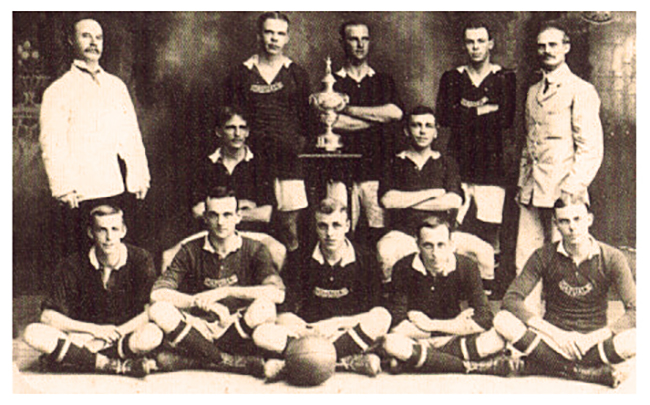
In 1907 F.N. Brierly and his brother George Alexander Brierly (1884-1930) helped found “The Casuals”, a football squad based in Port of Spain that played an extensive slate of matches intramurally and against other British colonies. The Casuals did not really live up to their name – they had all kinds of by-laws and bureaucratic procedures. In 1908 Frank, who played in the backfield, was voted captain.
The two brothers also shared an interest in the French female aristocracy – they both married into the Ganteaume family which had been in Trinidad since the 1790’s.
In the photo at left Frank, as captain of the team, is probably the man in the middle with the football. Based on facial resemblance and hair loss his older brother George is immediately to his right. (Just a guess.)
Due to the effects of female succession and emigration the name Brierly (or Brierley) no longer exists as a surname in Trinidad, but there is a Brierley Street in Sangre Grande where Frank made his rounds as a warden.
(For information linking Brierly and Herskovits I am indebted to Ryan Cecil Jobson and his article "Facing the Flames: The Herskovitses, Trinidad, and the Anthroplogical Imagination".)
23. A.J. Bernard, warden, Victoria St. Patrick, Princes Town
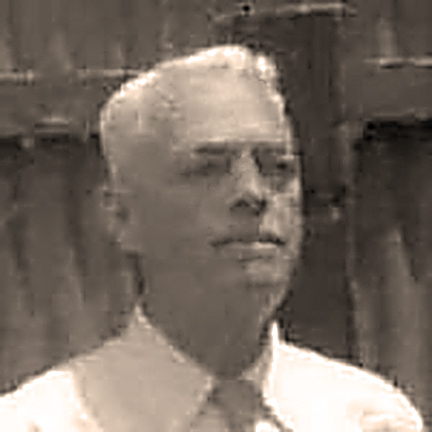
Andrew Joseph Bernard was born in Port of Spain on 7th January, 1892, the son of Felix Raymond Bernard who worked at the Commercial News Room, where the local businessmen would gather to read the latest dispatches from the West Indian and Panama Telegraph Company.
A.J. had an unusual education: at the age of fourteen he was sent to a seminary in Durham, England to study for the priesthood but he began to question his vocation and switched to St. Edmund’s, a private Catholic school in Hertfordshire. When he returned to Trinidad in 1910 he found that his Catholic education did not give him much of a boost. His first job was a clerkship in the prison system followed by a position in the warden’s office in Manzanilla. In 1912 he took a job in the colonial secretary’s office as a clerk in 6th position (there was a depth chart) at a yearly salary of £104 and was still there when World War I broke out.
Young, able-bodied and unattached, he was in an ideal situation to join the fight. He left Trinidad on 18th October 1915 and six months later arrived in France. On 21st November, 1916 he was commissioned as a second lieutenant in the 10th battalion of the Royal Warwickshire regiment.
On 7th July, 1917 he was wounded and sat out the rest of the war but he returned to France after Armistice Day in command of a “Labour Company” which meant putting German POWs to work cleaning up the place. While still in France he began lobbying the colonial government for a promotion in the civil service In his application He wrote the following:
“In Trinidad – Colonial Secretary’s office, or in any department, or in any ward of the island. Would prefer a post in the Administrative Branch of the Service. Would accept a post in any colony in the West Indies. Salary £250 - 300"
He sailed back to Trinidad on 17 April, 1919 but when he arrived home he was told that all the secretary of state for the colonies could do was offer him his old job back, but they did bump him up a notch to 5th position clerk at a salary of £150. His heroism and hard work in France was all for naught.
Things worked out better on the domestic front however. On 31st May, 1923 he married Doris Marie Agostini, a member of a wealthy and powerful family whose fortunes fluctuated with the price of sugar and cocoa. Doris’ great-grandfather Simon Agostini had arrived in Trinidad from his native Corsica in the 1790’s.
A.J. had eight children with Doris and he made a slow climb up the civil service ladder, eventually reaching the rank of warden. In 1943 his salary was announced as “$3360 to $4320” (dollars replaced pounds sterling) and he also got a traveling allowance.
A.J Bernard died in Port of Spain on 7th April, 1974.
24. John de Nobriga, warden, POS
Of all the 19th century immigrant groups in Trinidad the Portuguese were the most likely to mingle with all segments of the population. John de Nobriga (1886- ) grew up on Circular Road in the teeming Belmont section of Port of Spain. His father was a carpenter and his mother a seamstress. Nearby, on De Castro Lane, lived Albert Gomes (1911-1978) a second generation Portuguese who described Belmont this way in his autobiography Through a Maze of Colour (1974):
“Belmont, where we lived, was an easy-going suburb with its humble dwellings, churches and shops . . . Immediately at the back of our house, separated only by a wooden fence, were barrack-rooms where some three large families, children and all, were squeezed like sardines into rooms – a breeding ground of promiscuity, vice and disease. Yet, surprisingly, the people who had to endure these degrading conditions laughed, sang and danced, occasionally appearing pleased with their lives.”
Born c. 1875. In 1944 he was awarded the Companion of the Imperial Service Order medal "in recognition of 43 years' public service".
25. Miss Olga Huggins
When Lady Young was in Trinidad the surname Huggins was one of the most prominent names in the colony. The colonial secretary (later governor of Jamaica) was John Huggins. The wealthiest man on the island was the shipping magnate Sir George F. Huggins. It was perhaps because of this that many immigrants, some of them indentured labourers, chose the name Huggins when they wanted to Anglicize or change their names.
This was the case with the family of Olga Huggins. They arrived from China at some point in the 19th century. Details are lacking, but the family made remarkable strides in terms of social status. When Olga was born in 1903 she was firmly located in the upper middle class in Port of Spain.
As a young girl Olga was treated to tennis lessons and music lessons. She studied with Prof. Christian Nothnagel (1867-1932) who taught piano, organ, violin and cello at his home on Gray St. On 22 April, 1922 her musicianship was rewarded with "first honours" in an examination conducted by the London College of Music. On the sporting scene she was a mainstay of the Colonial Tennis Club on upper Frederick St. In 1933 she was ranked fifth in the colony in ladies’ singles.
Two of Olga’s brothers, Leonard Catesbuy Huggins and Donald Rhodes Huggins, both received medical degrees from the University of Edinburgh.
On travel documents Olga listed her occupation as “none” but it seems she was involved in the early days of the social work movement in Port of Spain with a special interest in the Chinese community. At a May, 1936 conference at the Princes Building she gave a lecture about her work that received a lot of attention. The conference was sponsored by the Coterie of Social Workers. It was probably on the basis of that that she was named to the executive committee of the Red Cross.
At the time of her appointment it appears she was unmarried. What became of her after that is not known.
26. Mrs. Jules Mahabir
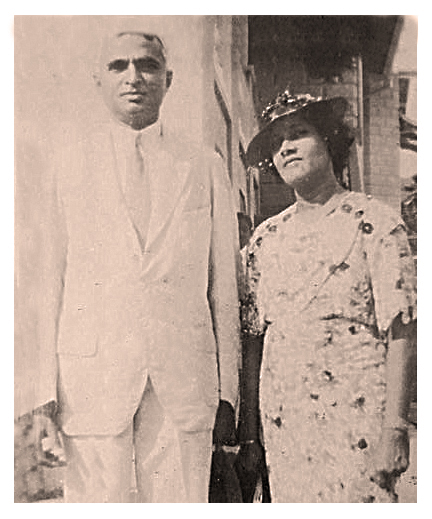
In 1986 Trinidadian novelist Sam Selvon wrote a short story called “Turning Christian.” In it two brothers from Calcutta, Jaggernauth and Changroo, are lured to Trinidad to take positions as indentured labourers in the cane fields. As the story begins Jaggernauth completes his indentureship and moves to San Fernando where he opens a small jewelry shop. His eyes opened to the ways of advancement in colonial Trinidad, he attempts to give his brother, still indentured, the secret to upward mobility:
“You got to turn Christian . . . only those Indians who turn Christian making any headway. Is not enough to talk the language . . .”
Between 1845 and 1917 more than 140,000 Indians were recruited to work in the cane fields of Trinidad. They were still British subjects but they came with a new identity – immigrants. This made it easier for some of them to vacate their culture and give up their faith – and they found Christian missionaries eager to convert them. This produced yet another line of division in a colony already crisscrossed by fault lines of national origin, race, language, religion and caste. It was these divisions that made colonies like Trinidad governable by a tiny clique of white Europeans.
The photo below shows two Presbyterian missionaries who arrived in Trinidad from Nova Scotia around 1870 – Kenneth J. Grant (seated, left) and John Morton. Standing in back are their
Indian students/converts. On the far left is a man named David Mahabir who grew up on a coconut estate where his mother was indentured, near what is now Point Fortin. Taking the path recommended above, he was baptised by Rev. Morton in 1874 and went on to become an elder in the Presbyterian church and a minor government official.

Seated are Kenneth J. Grant (left) and John Morton.
In the next generation the Mahabirs continued their climb – one of the sons, Jules, became Trinidad's first Indian magistrate. Around 1920 he married Minnie Mahabir (same last name) who was born in San Fernando in 1891. Minnie also had a Christian upbringing and received her early education at Dr. Mayhew’s School (AME) and Oriental Hall (Presbyterian).
Minnie and Jules combined to form a power couple that operated at the highest levels of legal, commercial, artistic and social realms in the south of Trinidad – with the understanding that their achievements would never place them on the same plane with whites.
In addition to her work at the Red Cross, Minnie was involved in the YWCA, Child Welfare Work, Mission Hand, Night Shelter Trust Board, Horticulture Club, India Club and the Xian End Societies. This last mentioned group was probably formed in response to the “Xi’an incident,” an important event in Chinese history that took place in Shaanxi Province in 1936. If so, it shows that Minnie was also influential in the Chinese community in Trinidad.
In her spare time (spare time?) she founded the Minerva Club in 1940 whose purpose was “to stimulate interest in literary matters and to develop character, comradeship and citizenship”. Between 1941 and 1944 the club published a quarterly literary magazine in Trinidad called the Minerva Review. One of the contributors was Seepersad Naipaul, father of the Nobelist.
Minnie passed away in 1957.
27. Dr. Gordon Deane
Although Dr. Deane was trained as a surgeon he took a job in Trinidad as a “DMO”, a District Medical Officer, which was a low-paying government job. His district included Couva, and that meant educating himself and immersing himself in the health woes of the “labouring population” – the children and grandchildren of indentured servants.
Among the many diseases confronting him was the tongue-twisting trio of xerothalmia (night blindness), ankylostomiasis (hookworm), and polyneuritis (beri-beri). Of the latter disease, Dr. Deane gave this graphic account:
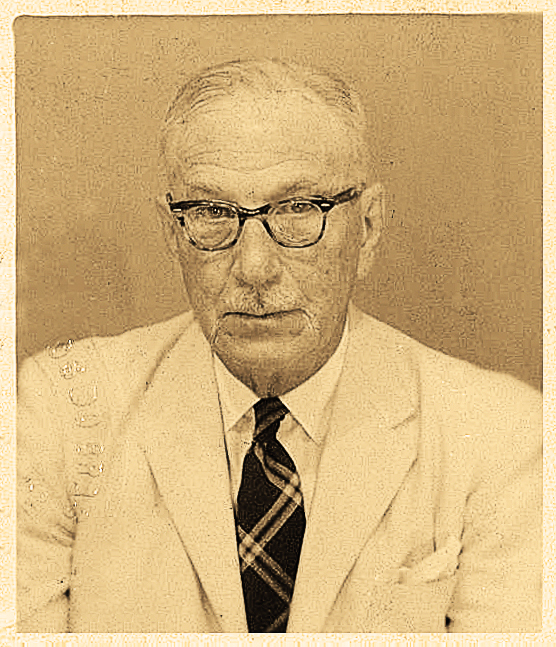
What was wanted, Dr. Deane felt, was a study of the problem, even though the cause was widely known – malnutrition. He began his study in 1930 and eight years later published a report that stated, “[W]e are now able to correlate certain features in the East Indian’s physical condition and in his feeding [diet] with much greater precision.” As to whether any steps were taken during this eight year period to improve the overall health of the working poor, the report did not say.
Charles Gordon Deane was born in Barbados on 26th December 1886. His father was a civil servant on the island in charge of a poor farm. He received his medical training at the University of Edinburgh, graduating in 1912. After completing his residency in Barbados he relocated to Trinidad for reasons unknown.
During WWI he served as a surgeon-captain in the British West Indies Regiment in France and Belgium. Thrown into battle in frigid conditions he was awarded the Military Cross for “constant devotion to duty and conspicuous bravery, for although hailing from a tropical climate, he remained for several hours barefooted in the snow attending to the wounded.”
On 20th January, 1923 he married Thelma Rosina Dumoret in Santa Cruz. She was sixteen years his junior.
Dr. Deane was an avid golfer and a member of the St. Andrews Golf Club which at that time was located in Maraval on the former Boissiere estate known as “Champs Elysees”. In 1938 he realized the ultimate fantasy of any golfer – he purchased a lot on Golf Course Road and built a house overlooking the first tee. Later the property was purchased by the Dominion of Canada as a private residence for the Canadian High Commissioner. The golf course is gone now but the area is known as “Fairways.”
His wife, Thelma, passed away in 1953 and after that Dr. Deane decided to cut his ties with Trinidad. He sold his house on Golf Course Road and moved back to Barbados.
28. Miss Sophie Potter
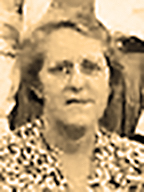
Sophie Edith Margaret Potter was born in Port of Spain on 27th June, 1895, the eldest of nine children of Thomas Irwin Potter and Alice Mary (Mecham) Potter. She had eight younger brothers! Her father was a famed naturalist who can rightly be called Trinidad’s first environmentalist. The Potter children all made significant contributions to the colony in the fields of education, agriculture and scouting.
On the veranda of the family home on Alexandra St. Sophie set up an informal but highly regarded primary school for boys. After her parents' death Sophie took in boarders to help make ends meet.
She died in Port of Spain in 1977.
29. Mr. W. L. McLachlan
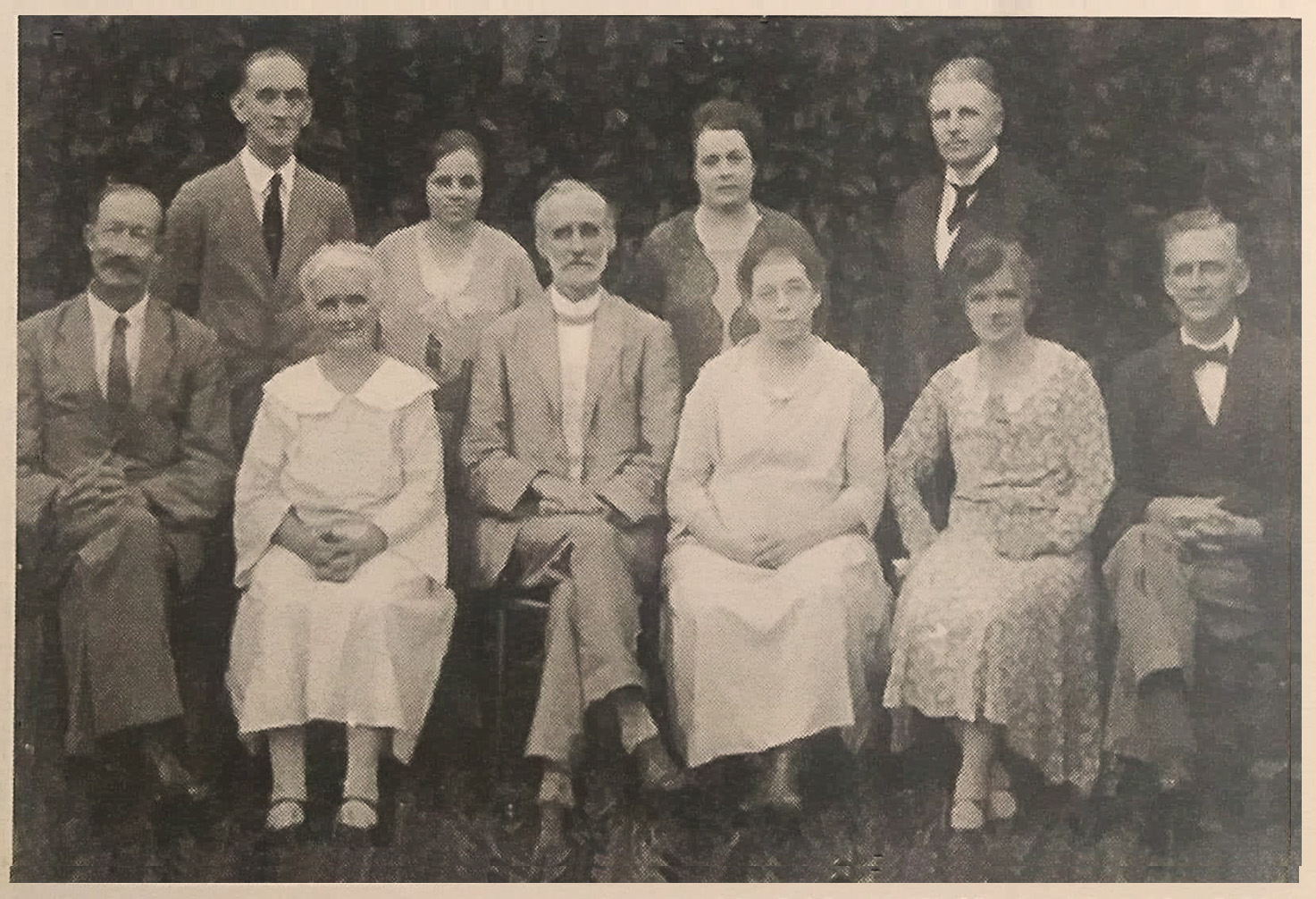
In the front row middle are John W. McLachlan and Alice C. McLachlan.
This was William Lindsay McLachlan (1903-1977), a banker by trade (Royal Bank of Canada), whose presence on the committee was probably due to his involvement in the scouting movement in Trinidad. On 12th May 1937 he attended the coronation of King George VI as a representative of the Boy Scouts. He was also a director of Harrison Ltd., a shipping company that serviced Trinidad out of Liverpool.
He was born in Yorkshire, England, the son of John W. and Alice C. McLachlan who were “commended missionaries” in the Christian Brethren movement. With William still a toddler the Mclachlans set out for Barbados where they met a fellow missionary who recommended Trinidad as a “wicked place” much in need of soul-saving. Intrigued, the McLachlans arrived in Trinidad in 1910 and set up their mission in the Belmont neighborhood of Port of Spain. On 27th February 1910 they conducted their first “breaking of the bread” there with a congregation of five baptised believers. Later they opened a gospel hall in Belmont.
His boyhood in Belmont immersed William in a Trinidadian society that very few British people ever saw. (For a fuller description of Belmont see the entry above for John de Nobriga.)
In 1930 he married a Barbadian woman, Ena Eleanor Chase, and they had two children, Lindsay Harold McLachlan (1931-1971) and Eleanor June McLachlan (1941-?) who may still be alive. William had two brothers, John and Samuel, but it appears that neither of them was able to carry on the bloodline into the next generation in Trinidad.
In 1930 he married a Barbadian woman, Ena Eleanor Chase, and they had two children, Lindsay Harold In 1930 he married a Barbadian woman, Ena Eleanor Chase, and they had two children, Lindsay Harold McLachlan (1931-1971)In 1930